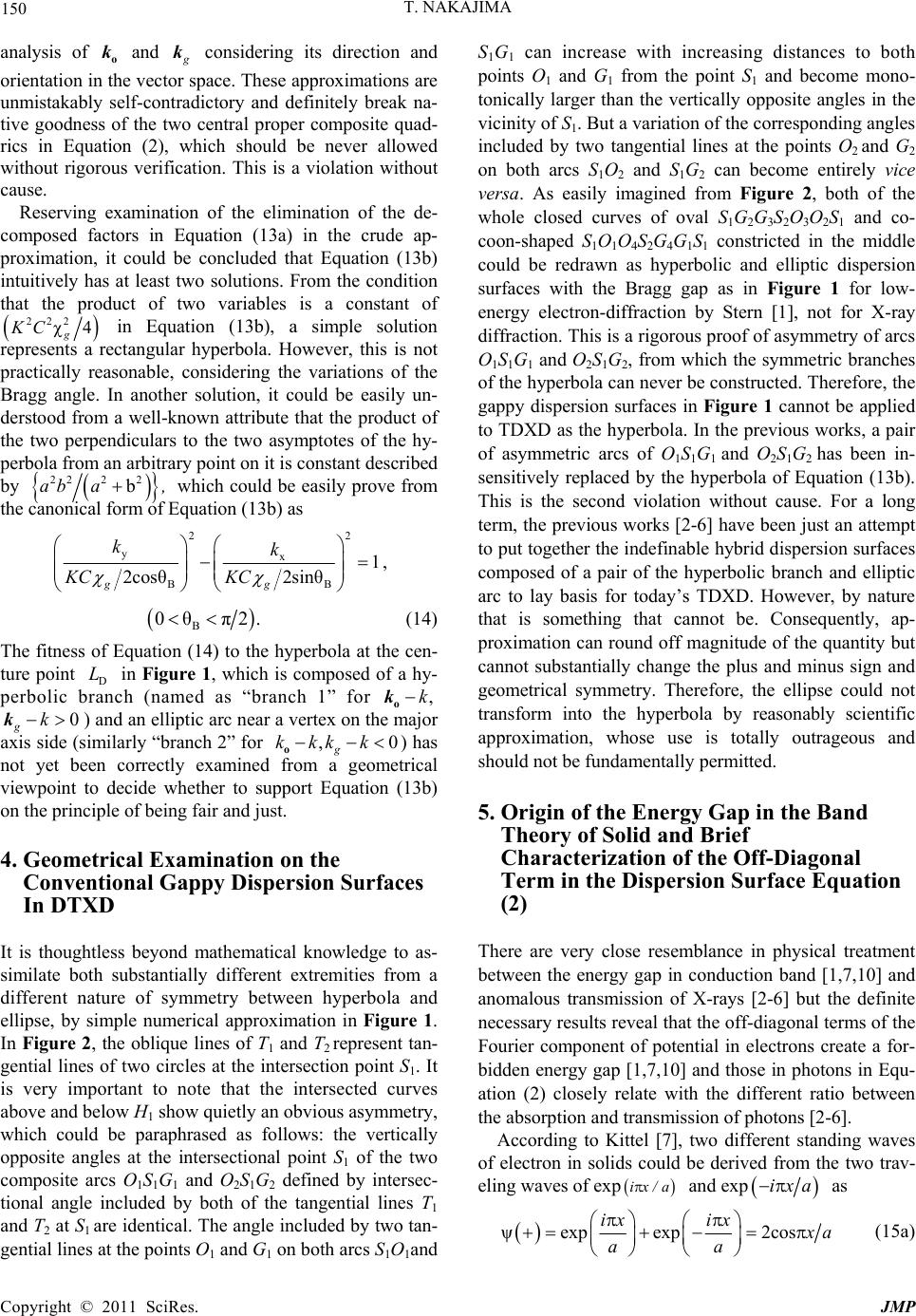
150 T. NAKAJIMA
analysis of and
ko
k considering its direction and
orientation in the vector space. These approximations are
unmistakably self-contradictory and definitely break na-
tive goodness of the two central proper composite quad-
rics in Equation (2), which should be never allowed
without rigorous verification. This is a violation without
cause.
Reserving examination of the elimination of the de-
composed factors in Equation (13a) in the crude ap-
proximation, it could be concluded that Equation (13b)
intuitively has at least two solutions. From the condition
that the product of two variables is a constant of
222
χ4
g
KC
in Equation (13b), a simple solution
represents a rectangular hyperbola. However, this is not
practically reasonable, considering the variations of the
Bragg angle. In another solution, it could be easily un-
derstood from a well-known attribute that the product of
the two perpendiculars to the two asymptotes of the hy-
perbola from an arbitrary point on it is constant described
by
22 22
bab a, which could be easily prove from
the canonical form of Equation (13b) as
2
yx
BB
1
2cosθ2sinθ
gg
kk
KC KC
2
,
B
0θπ2.
(14)
The fitness of Equation (14) to the hyperbola at the cen-
ture point D in Figure 1, which is composed of a hy-
perbolic branch (named as “branch 1” for
L
,k
o
k
0
gkk) and an elliptic arc near a vertex on the major
axis side (similarly “branch 2” for ) has
not yet been correctly examined from a geometrical
viewpoint to decide whether to support Equation (13b)
on the principle of being fair and just.
, 0
g
kkkk
o
4. Geometrical Examination on the
Conventional Gappy Dispersion Surfaces
In DTXD
It is thoughtless beyond mathematical knowledge to as-
similate both substantially different extremities from a
different nature of symmetry between hyperbola and
ellipse, by simple numerical approximation in Figure 1.
In Figure 2, the oblique lines of T1 and T2 represent tan-
gential lines of two circles at the intersection point S1. It
is very important to note that the intersected curves
above and below H1 show quietly an obvious asymmetry,
which could be paraphrased as follows: the vertically
opposite angles at the intersectional point S1 of the two
composite arcs O1S1G1 and O2S1G2 defined by intersec-
tional angle included by both of the tangential lines T1
and T2 at S1 are identical. The angle included by two tan-
gential lines at the points O1 and G1 on both arcs S1O1and
S1G1 can increase with increasing distances to both
points O1 and G1 from the point S1 and become mono-
tonically larger than the vertically opposite angles in the
vicinity of S1. But a variation of the corresponding angles
included by two tangential lines at the points O2 and G2
on both arcs S
1O2 and S
1G2 can become entirely vice
versa. As easily imagined from Figure 2, both of the
whole closed curves of oval S1G2G3S2O3O2S1 and co-
coon-s hap ed S
1O1O4S2G4G1S1 constricted in the middle
could be redrawn as hyperbolic and elliptic dispersion
surfaces with the Bragg gap as in Figure 1 for low-
energy electron-diffraction by Stern [1], not for X-ray
diffraction. This is a rigorous proof of asymmetry of arcs
O1S1G1 and O2S1G2, from which the symmetric branches
of the hyperbola can never be constructed. Therefore, the
gappy dispersion surfaces in Figure 1 cannot be applied
to TDXD as the hyperbola. In the previous works, a pair
of asymmetric arcs of O1S1G1 and O2S1G2 has been in-
sensitively replaced by the hyperbola of Equation (13b).
This is the second violation without cause. For a long
term, the previous works [2-6] have been just an attempt
to put together the indefinable hybrid dispersion surfaces
composed of a pair of the hyperbolic branch and elliptic
arc to lay basis for today’s TDXD. However, by nature
that is something that cannot be. Consequently, ap-
proximation can round off magnitude of the quantity but
cannot substantially change the plus and minus sign and
geometrical symmetry. Therefore, the ellipse could not
transform into the hyperbola by reasonably scientific
approximation, whose use is totally outrageous and
should not be fundamentally permitted.
5. Origin of the Energy Gap in the Band
Theory of Solid and Brief
Characterization of the Off-Diagonal
Term in the Dispersion Surface Equation
(2)
There are very close resemblance in physical treatment
between the energy gap in conduction band [1,7,10] and
anomalous transmission of X-rays [2-6] but the definite
necessary results reveal that the off-diagonal terms of the
Fourier component of potential in electrons create a for-
bidden energy gap [1,7,10] and those in photons in Equ-
ation (2) closely relate with the different ratio between
the absorption and transmission of photons [2-6].
According to Kittel [7], two different standing waves
of electron in solids could be derived from the two trav-
eling waves of exp
ix/a and exp
ixa as
ψexp exp2cos
ix ix
a
aa
(15a)
Copyright © 2011 SciRes. JMP